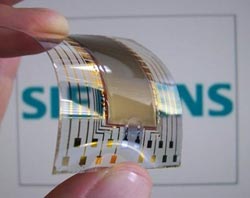Project HOP-X: Organic Detectors for X-Rays

<br>
This technology has the potential to substantially reduce production costs and also promises better image resolution than is possible with today's detectors. The innovation involves mixing specific substances into organic detector materials.
The substances involved absorb X-ray radiation, which is converted into visible light. Siemens' global Corporate Technology department is coordinating a three-year government-funded project known as HOP-X, in which the associated technology will be developed and demonstrated.
According to experts, initial potential applications include mammography devices and conventional X-ray machines.
Most of today's X-ray detectors consist of a scintillator coating that converts X-rays into visible light and a photodiode that registers the light in pixels. The savings potential offered by this amorphous silicon-based technology is largely exhausted, however. Today's units also have a dose-measurement chamber that monitors the set dose from a position between the patient and the detector.
This chamber must not be allowed to affect the X-ray image produced. Ionization measurement chambers have been used for this application up until now. However, such chambers are not sufficiently sensitive or shadow-free for the low doses of radiation that today's X-ray machines are capable of emitting.
Organic photo detectors can improve both aspects. These detectors are based on organic plastics and can be sprayed or printed onto a substrate at a low cost. This largely decouples production costs from the detector surface area, which is not the case with crystalline detectors. The organic diodes can also be used as dose-measurement chambers. They are more sensitive than ionization measurement chambers and can be structured more easily, which means the measurement unit can be adjusted to individual patient dimensions and dose regulation can be controlled more effectively.
The problem is that organic photodiodes mostly detect visible light. That's why Siemens researchers are developing special nanoparticles that can be mixed into the organic plastic solution as scintillators. Other project partners are examining an alternative that involves admixing semiconductor nanocrystals that directly absorb X-ray light, which is forwarded to the organic detector matrix in the form of electrons. Siemens is also responsible for the design of the new photodiodes and the creation of demonstration systems. The other Hop-X partners are Merck KgaA, the Leibniz Institute for New Materials and CAN-GmbH.
Media Contact
More Information:
http://www.siemens.com/innovationnewsAll latest news from the category: Physics and Astronomy
This area deals with the fundamental laws and building blocks of nature and how they interact, the properties and the behavior of matter, and research into space and time and their structures.
innovations-report provides in-depth reports and articles on subjects such as astrophysics, laser technologies, nuclear, quantum, particle and solid-state physics, nanotechnologies, planetary research and findings (Mars, Venus) and developments related to the Hubble Telescope.
Newest articles

Silicon Carbide Innovation Alliance to drive industrial-scale semiconductor work
Known for its ability to withstand extreme environments and high voltages, silicon carbide (SiC) is a semiconducting material made up of silicon and carbon atoms arranged into crystals that is…

New SPECT/CT technique shows impressive biomarker identification
…offers increased access for prostate cancer patients. A novel SPECT/CT acquisition method can accurately detect radiopharmaceutical biodistribution in a convenient manner for prostate cancer patients, opening the door for more…

How 3D printers can give robots a soft touch
Soft skin coverings and touch sensors have emerged as a promising feature for robots that are both safer and more intuitive for human interaction, but they are expensive and difficult…





















